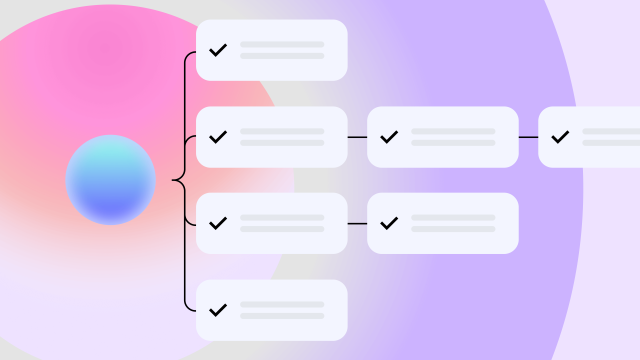Enterprise transformation
– 16 min read
Enterprise guide to agent washing: Avoid million-dollar AI agent mistakes

We’ve hit peak “agent.” The term is everywhere — in product launches, pitch decks, analyst reports. And yet, the more it shows up, the less it seems to mean. What used to describe systems with real autonomy and decision-making is now being slapped on tools that are little more than chatbots with good lighting.
This kind of overstatement isn’t just annoying — it’s risky. Especially for enterprises in high-stakes, high-regulation industries like healthcare, finance, and consumer goods. When marketing spin outpaces technical reality, companies waste time, money, and trust. Increasingly, they also face legal and regulatory risk.
It’s time to get clear: What is a true AI agent? What isn’t? And how do you avoid getting duped by vendor hype? Let’s dig in.
- Agent washing is the deceptive practice of marketing basic automation tools as sophisticated AI agents, leading enterprises to waste millions on systems that can’t deliver the promised autonomy and capabilities.
- Companies should evaluate AI systems using a 4-level framework ranging from simple assistive agents (Level 1) to complex multi-agent systems (Level 4), with most misrepresentation occurring when companies market Level 1 tools as Level 3 or 4 capabilities.
- The most effective enterprise AI systems use hybrid approaches that strategically combine deterministic infrastructure (rules, protocols, safety rails) with probabilistic intelligence (reasoning, creativity, adaptation) rather than purely autonomous systems.
- To avoid agent washing, enterprises should demand transparency about autonomy levels, evidence of real-world performance, and clear explanations of failure modes instead of accepting vague marketing promises about “AI-powered” capabilities.
- WRITER’s Action Agent demonstrates genuine Level 3 autonomy by providing radical transparency through real-time todo.md files, operating in secure sandboxed environments, and actually executing complex multi-step tasks rather than just connecting to tools.
What’s AI agent washing, and why is misrepresentation so risky?
Agent washing is the practice of rebranding basic automation as sophisticated AI agents without being transparent about the actual level of autonomy and AI involvement. These mislabeled systems often combine simple rule-based automation with minimal AI capabilities, then market themselves as if they were highly autonomous reasoning systems.
The problem isn’t that these tools use deterministic logic — the problem is misrepresentation. When enterprises expect autonomous decision-making but get rigid automation, they set themselves up for failure (or at minimum, distraction) as it pertains to getting the most out of AI’s transformative potential and the value of having a dedicated AI strategy to drive better outcomes.
There’s a world where basic automation tools do drive real value. But agent washing doesn’t just mislead — it actively prevents companies from realizing AI’s transformative potential by keeping them focused on incremental improvements instead of breakthrough capabilities:
- Companies waste their budgets on basic automation tools that only deliver marginal gains instead of investing in AI systems that can fundamentally change how work gets done
- Organizations miss the chance to solve their most complex, high-value problems — the kind that require genuine AI reasoning and multi-step execution to open exponential returns
- Teams end up with a patchwork of disconnected AI tools instead of building integrated AI capabilities that transform entire workflows and business processes
Too many organizations get caught up in the “agent” label without understanding what they actually need. As WRITER’s production AI team has learned from deploying systems with enterprises like Uber and Franklin Templeton, not every nail needs a sledgehammer — or an autonomous agent. A simple FAQ generator that works 95% of the time beats a sophisticated reasoning system that works 80% of the time but costs 10x more to run.
This isn’t just about cost. It’s about ownership, control, and the difference between dabbling in AI and strategically using it to drive real, measurable value and ROI. That’s the foundation of true competitive advantage.
Agent washing red flags: How misrepresentation creates business risk
We’re already seeing signs of the backlash. In 2024, the FTC launched “Operation AI Comply” to crack down on deceptive AI marketing. In 2025, the SEC charged Presto Automation for misleading investors with inflated AI claims. And DoNotPay’s so-called “AI lawyer” made headlines for providing inadequate AI legal services that failed to match human lawyer performance.
Watch out for these mismatched expectations:
- Promising full autonomy while delivering structured automation — like Presto’s “AI” that needed human assistance for 70%+ of orders
- Vague promises of “AI-powered” without explaining the actual autonomy level — buzzword salad that avoids specifics about deterministic vs. probabilistic behavior
- Marketing low-autonomy tools as high-autonomy systems — structured automation rebranded as adaptive intelligence
- No mention of failure modes, edge cases, or human oversight requirements — every system on the autonomy spectrum has limitations
- Inability to explain the hybrid architecture — how deterministic and probabilistic components work together
- Demo-perfect performance that doesn’t translate to production — impressive, controlled demos that fall apart in real workflows with unpredictable inputs
- Claims of reasoning without evidence of actual adaptation — following predetermined logic isn’t the same as contextual decision-making
Agent washing isn’t just a branding problem — it’s a business risk that stems from mismatched expectations about autonomy levels.
Understand the AI autonomy spectrum to prevent agent washing
Rather than getting caught up in “agent” vs. “not agent” debates, focus on the spectrum of autonomy and the strategic mix of deterministic and probabilistic behavior. At WRITER, we’ve seen this play out in production deployments — the most successful systems aren’t necessarily the most autonomous.
Here’s how to think about the autonomy spectrum:
Structured automation (Low autonomy)
These systems use structured prompts, clear guardrails, and predictable outputs. Think about auto-generating FAQ documents from your vacation policy or creating status reports from project data. They do one thing very well and fail gracefully when they encounter edge cases. Deterministic infrastructure with minimal probabilistic intelligence.
Hybrid intelligence (Medium autonomy)
These combine deterministic processes with AI capabilities at specific decision points. A contract review workflow might use rule-based checks for standard clauses but call an LLM for semantic analysis of unusual terms. The key is knowing where context understanding adds value and where traditional logic is more reliable.
Adaptive systems (High autonomy)
These need autonomy for open-ended tasks like deep research or complex problem-solving. They can reason, plan, and act independently, but they’re expensive — both computationally and in terms of unpredictable behavior.
Collaborative networks (Full autonomy)
Multi-agent systems where agents communicate, pass tasks, and execute in coordination. These are ideal for complex workflows like processing full procurement or resolving IT incidents end-to-end.
The production reality: Teams often default to high-autonomy agents because they’re impressive in demos, but today, structured automation and hybrid systems deliver more business value.
Today’s most effective agent systems use a hybrid approach: deterministic infrastructure (schemas, protocols, safety rails) combined with probabilistic intelligence (reasoning, creativity, adaptation). Think of it like building a jazz band — you need solid musical structure so musicians can improvise brilliantly.
A practical framework to evaluate vendor claims and avoid misrepresentation
While the autonomy spectrum helps you think strategically about AI architecture, you also need a practical way to categorize and evaluate vendor offerings. At WRITER, we use a 4-level framework to help enterprises cut through marketing claims:
Level 1: Assistive agents
These use language models to automate simple tasks based on instructions and prompts. Input goes in, output comes out. No external data or actions required. Think automated FAQ generation or content recaps. Mostly deterministic with minimal probabilistic components.
Level 2: Knowledge agents
These deliver context-rich outputs by integrating enterprise knowledge through retrieval-augmented generation (RAG). They pull from internal documents and databases to provide informed responses. Hybrid approach with deterministic retrieval and probabilistic synthesis.
Level 3: Action agents
These automate tasks by connecting to external tools and APIs. They can send emails, update Salesforce records, or publish content to platforms. They have “tool calling” capabilities that extend beyond built-in knowledge. More probabilistic decision-making within deterministic guardrails.
Level 4: Multi-agent systems
These involve networks of agents collaborating to achieve complex goals. Multiple agents communicate, pass tasks, and execute in coordination — like processing full procurement workflows or resolving IT incidents end-to-end. Complex orchestration of multiple deterministic and probabilistic components.
Most mismatched expectations happen when vendors market Level 1 assistive tools as if they were Level 3 or 4 systems. To avoid misrepresentation, evaluate what level you need — and what level companies are selling you.
How to evaluate AI systems across the autonomy spectrum
Rather than asking, “Is this a real AI agent?” ask, “What level of autonomy does this system actually provide, and does that match my business needs?” True enterprise AI success comes from right-sizing your solution to the problem at hand.
Here’s what to evaluate:
1. Transparency about deterministic vs. probabilistic components
Ask vendors to clearly explain which parts of their system follow predetermined rules and which parts use AI for contextual decision-making. The best systems strategically combine both.
2. Evidence of appropriate autonomy level
Does the system’s level of autonomy match the complexity of your use case? Simple, repeatable tasks might need structured automation, while complex problem-solving might need adaptive systems.
3. Clear failure modes and guardrails
Every system on the autonomy spectrum has failure modes. Vendors should clearly explain what happens when the system encounters edge cases and what guardrails prevent dangerous failures.
4. Integration architecture
How does the system integrate with your existing workflows and data sources? Higher autonomy systems should have strong integration capabilities, while lower autonomy systems might work well in isolated workflows.
5. Learning and adaptation mechanisms
For systems claiming higher autonomy — How do they actually learn and improve over time? Can they adapt to new scenarios, or do they require retraining and redeployment?
Autonomy isn’t the absence of supervision — it’s the ability to act within well-defined goals, rules, and environments. At WRITER, we’ve seen firsthand that enterprise AI agents require more than a clever prompt or a fine-tuned model. As CEO May Habib has pointed out, “Agents don’t reliably follow rules. They are outcome-driven. They interpret. They adapt. And the behavior really only emerges in real-world environments.”
In other words, autonomy isn’t a static capability — it’s emergent. It develops through trial, context, and iteration. And as Waseem AlShikh has noted, “The way we define [reasoning] here at WRITER is can we actually build a system, and can that system do two specific tasks — self-organize and self-assembly — and can do it always in the correct way at scale.”These qualities — adaptation, emergence, and contextual performance — are what make autonomy powerful. But they also make it unpredictable. That’s why real-world supervision, evaluation, and governance are essential. Especially in live, regulated, customer-facing environments.
The agent-washing checklist: Cut through hype and focus on outcomes
Here’s what enterprise leaders should do to cut through the hype:
Define what autonomy means to you
Don’t let vendors define the bar. Set your standards for autonomy, learning, and decision-making — and share them with procurement and IT teams.
Ask tough questions
How does this agent learn? What happens when priorities shift? Can it operate across systems? What level of human supervision does it require? If you’re not getting clear answers, you’re probably getting agent-washed.
Start with the business outcome: If a vendor can’t explain the business outcome in one sentence, you’re looking at a solution in search of a problem. The best AI deployments start with clear metrics — like reducing contract review time from four hours to 90 minutes — not vague promises of “better” or “smarter” processes.
Right-size the solution: Don’t reach for autonomous agents when simpler solutions would deliver better results faster. Ask vendors to justify why you need Level 3 or 4 capabilities when a Level 1 or 2 solution might solve your actual problem more reliably and cost-effectively.
WRITER’s engineering team has seen what recent studies confirm — multi-agent LLM systems often underperform in production settings. The root causes aren’t just poor prompting — they’re systemic. Successful agentic systems require thoughtful architecture, aligned incentives, and ongoing coordination. It’s not about prompt engineering. It’s systems engineering.
Pilot before you scale
Start small. Run a proof of concept with a real-world workflow. Measure whether the agent reduces manual work, makes smart decisions, and improves over time. If it doesn’t — cut your losses.
Demand evidence, not just a roadmap
Marketing decks are cheap. Results are not. Ask for customer case studies, in-product demos, and measurable outcomes. If the agent can’t show real-world success, don’t buy the story.
Focus on user impact over model metrics: Don’t get distracted by technical accuracy scores or boasts about state-of-the-art performance on academic benchmarks. Ask — How often do users accept the AI’s first draft? How much time do they save per task? What’s the failure rate in critical workflows? Production AI success comes from systems that measurably improve business processes, not just impressive benchmark scores.
Tie AI to business value
Don’t adopt agents just because everyone else is. Focus on use cases where autonomy can reduce costs, increase speed, or improve quality. If a tool doesn’t move the needle, it’s not worth deploying.
Introducing Action Agent: High autonomy with enterprise-grade control
Action Agent is WRITER’s autonomous AI that actually executes work instead of just giving advice. Unlike traditional chatbots that tell you what to do, Action Agent does the work for you — researching markets, building financial models, creating presentations, writing code, and delivering complete projects.
For enterprise users, this means you can delegate complex, multi-step tasks that typically take hours or days. Need competitive intelligence? Action Agent will search the web, pull data from multiple sources, analyze your competitors’ strategies, and create a strategic brief. Want to analyze customer data? It’ll connect to your databases, process your datasets, run the analysis, and generate charts and recommendations. Building a new workflow? It can call APIs, write the code, test it, and deploy a working solution.
The challenge with high-autonomy systems has always been the trade-off between power and control. How do you unleash an agent to solve complex problems without creating unacceptable business, security, or compliance risks?
This is where WRITER’s Action Agent provides a new path forward. It’s designed from the ground up to deliver on the promise of high autonomy (Level 3 and 4) while providing the transparency and enterprise-grade controls necessary to operate safely.
Action Agent avoids the “agent washing” pitfalls by design:
- Instead of vague promises, it shows you exactly what it’s doing. Action Agent breaks down your request into clear, actionable steps and saves them in a simple todo.md file. You can watch its plan unfold in real-time — no mystery about what’s happening behind the scenes.
- Instead of hiding when things go wrong, it learns from mistakes. Action Agent follows a straightforward process — it takes action, checks if it worked, and fixes problems when they arise. If a script fails or a tool breaks, it figures out what went wrong and tries a different approach.
- Instead of running fragile demos, it works in a secure, real environment. Each session gets its own private Linux computer that’s completely isolated from your systems. Everything the agent does is logged and auditable, giving you enterprise-level security without sacrificing power.
- Instead of just connecting to tools, it actually gets work done. Action Agent doesn’t stop at making API calls. It writes and runs code, analyzes data and creates charts, builds websites, fills out web forms, and handles complex multi-step tasks from start to finish.
Action Agent proves that you don’t have to choose between powerful autonomy and rigorous control.

WRITER Action Agent
Learn more
Clarity is your best defense against agent washing
There’s real promise in AI agents. But mislabeling tools doesn’t get us there.
Gartner predicts that by 2028, 15% of day-to-day work decisions will be made autonomously by agentic systems. That only works if companies understand what they’re buying and why. The smartest strategy in a world of agent washing?
Look beyond the shiny exterior. Ask hard questions. Insist on real autonomy.
Because misrepresentation is the problem. And clarity is your competitive edge.
Ready to deploy real AI agents that drive business value? Learn more about WRITER’s enterprise AI platform and our approach to production-grade agentic systems.
Frequently asked questions
What is agent washing?
Agent washing is the practice of marketing basic automation tools as AI agents with higher-level autonomy, reasoning, and learning capabilities — often without evidence to back those claims.
Why is agent washing a problem for enterprises?
It leads to wasted investment, misaligned expectations, operational risk, and missed opportunities for applying AI strategically to drive ROI.
How can I tell if an AI agent is legitimate?
Ask for clarity on its autonomy level, how it handles failure, whether it learns or adapts, and what business outcomes it supports. Use WRITER’s 4-level framework to assess what you’re really getting.
What’s the difference between structured automation and agentic AI?
Structured automation uses deterministic logic for narrow tasks. True agentic AI includes learning, adaptation, and some level of independent decision-making — often combining probabilistic and deterministic methods.
How can I tell if an AI agent is real or just marketing hype?
Look for five key capabilities — adaptability, continuous learning, autonomous decision-making, end-to-end integration, and ability to handle unstructured data. Use our 4-level framework to categorize what you’re actually getting.
What’s the difference between Level 1 and Level 4 AI agents?
Level 1 agents are simple assistive tools that follow basic prompts, while Level 4 agents are multi-agent systems that collaborate on complex workflows. Most agent washing involves marketing Level 1 tools as Level 3 or 4 capabilities.
How much money do companies lose to agent washing?
Companies waste millions on tools that can’t scale, miss opportunities for real AI value, and face compliance risks from overpromised capabilities. The FTC and SEC are now actively prosecuting deceptive AI claims.
How should I evaluate an AI vendor’s claims?
Ask for proof in the form of case studies, demos, integration details, and real metrics tied to outcomes — not vague references to autonomy or intelligence.
What should I ask vendors to avoid getting agent-washed?
Start with business outcomes: Can they explain the value in one sentence? Ask for proof of autonomy, learning capabilities, and real customer results. Demand evidence over roadmaps.
How does WRITER Action Agent address the “black box” problem in AI?
Action Agent aims for radical transparency. It operates in a secure, sandboxed environment and provides a complete, code-first view of its entire execution loop. Every command, decision, and line of code it runs is logged and fully auditable, giving enterprises the visibility they need to ensure compliance and debug processes.
Can Action Agent be safely used in highly regulated industries like finance or healthcare?
Yes. Action Agent’s architecture focuses on enterprise security and governance. By providing a transparent, auditable workflow and integrating with existing enterprise security protocols (like identity and data governance systems), it allows companies in regulated fields to leverage advanced AI without compromising on compliance.
Is Action Agent just another chatbot with API access?
No. While many “agents” are Level 1 assistive tools, Action Agent is a true Level 3 autonomous agent. It doesn’t just follow linear prompts; it can independently create a multi-phase plan, select the right tools for the job, and adapt its strategy based on new information to achieve a complex, high-level goal.




